
© Sarah Walker. (Click image for larger version)
Dance Massive 2015: Rebecca Jensen & Sarah Aiken
Overworld
Melbourne, Arts House at North Melbourne Town Hall
10 March 2015
becandsarah.tumblr.com
dancemassive.com.au
www.melbourne.vic.gov.au/artshouse/
In Overworld, we enter into a sacred space.
Or at least, it seems as though we are entering into a sacred space. Divested of all personal belongings in the foyer (and therefore somewhat stripped of the trappings of our normal identities), we are bestowed with new roles as ambassadors for our astrological signs. Born in July – I am a water sign, a Cancer, a wearer of blue. We are slowly led in single file to stand along the rim of a pentacle inscribed with items of clothing. There is lycra and faux fur, bikini bottoms, scarves and silken robes – an op shop explosion organised for the evocation of the spirits. Within the womb of the star lie four females in sheer white dresses (Sarah Aiken, Rebecca Jensen, Janine Proost and Rachel Coulson). After a slow and ritualistic emerging that references the movements of bugs and animals, restful repose gives way to jogging sequences in precise, militaristic formations. It is as though the dancers are marshalling their bodies, collecting energy for some as-yet-unknown purpose. From its use of repetition in movement to the second-hand clothing that dominates Rose Connors Dance’s set design, Overworld is a conscious adherent to the cult of recycling, reimagining symbols and items for newer, and perhaps more obscene, purposes.
Later, we will each have an intimate encounter with our self-proclaimed goddesses (including a palm reading for some) and the opportunity to dress our goddess in items of clothing from the floor (all blue, of course, for those of us lucky enough to identify as Cancer, Pisces or Scorpio). Now draped in the cast-off clothing of strangers, the four goddesses battle for supremacy, ripping scarves, gloves, robes and skirts off one another’s bodies. At the end, one goddess is left stripped entirely bare, cast down amid the debris of cloth and silk and beading and every kind of synthetic material imaginable. This is a rape of sorts; a stripping of identity and a desecration of the formality that characterises the start of the work. Footage of the battle, recorded in real-time on four smartphones (that miraculously survive the wrestling match) is replayed in the darkness. Flickering lights from four tiny screens offer a virtual re-enactment of the fall of the goddess, rather like ceremonial candles illuminating patches of bare flesh.

© Sarah Walker. (Click image for larger version)
From there, Overworld veers into a group meditation and the audience is invited to ‘relive a past life’ from our new positions on loungers at one end of the space. In this sense, we have come full circle, taking on the role of the goddesses in repose, peering down with half-closed eyes to where the dancers move in slow motion, inscribing circles with their limbs. Is this a rebirth, perhaps, after death? Or is it simply a re-centring of a work that has dipped into the chaos of iconoclasm and a reclaiming of feminine strength? At the very end, however, the four women vamp to the sexualised lyrics of pop singer Jason Derulo. This time, their faces are projected large through the lens of a video camera and onto screens on either side of a makeshift stage as they dress, strip and re-dress in a series of baggy tops and oversized sunglasses. As the stage fades to black, Derulo mutters “Damn, baby, you got a bright future behind you,” an ending in lyrical form that subverts the sacred into the misogynistic.
Created by emerging choreographers Rebecca Jensen and Sarah Aiken, Overworld plays with the unleashing of feminine magic into the confinement of a theatrical space, as well as an investigation into chaos and mystery, and the representation of the female body as goddess, victim, and sex toy. As Jensen and Aiken suggest, Overworld is the story of “four goddesses who rise from the debris of pop culture”. But such a statement feels inadequate for what is a highly complex exploration of female sexuality, myth, and ritual. It is a strange and compelling work despite very real structural problems that can be attributed to overlong improvised sequences.
For several years, Jensen and Aiken have created a framework for participatory fitness/performance events that play with notions of spirituality (or rather, a kind of ironic pseudo-spirituality), mining different cultures, rituals, and ceremonies for material to apply to a contemporary dance practice. Jensen and Aiken fashion themselves as hipster priestesses in these works, dividing up their acolytes – the audience members – using star signs and horoscopes to provide a kind of artificial division and structure. Heavily interspersed with new age mysticism, yoga and a cult-like fetish of the body, Jensen and Aiken do not seem to be content to focus solely on a theatrical presentation, but rather on developing an ‘experience’ for their audience; in this sense, their work can almost be framed as performance art or installation.

© Sarah Walker. (Click image for larger version)
In the past few years, Jensen and Aiken have created an experiential art group, Deep Soulful Sweats, that specialises in work that intersects contemporary dance performance with pseudo-spiritual experience. According to reports, the work of Deep Soulful Sweats was inspired by Jensen’s attendance at a ‘Witch Camp’ in Germany. Through that experience, she and Aiken found fodder for participatory performance that connects with a pop-culture interest in the supernatural, spiritual and astrological. In the performance of their quasi-mystical combination of aerobics, yoga and dancing, along with “senseless chanting and choreographic configurations,” Deep Soulful Sweats exploits a burgeoning interest in the ‘mystic’ and spiritual while naming the experience as “faux ritual”. There is little talk of participatory performance as a cathartic experience here, nor any expectation of a paradigm-shifting, life-changing event. Rather, Deep Soulful Sweats offers an opportunity to ‘get sweaty’ and to have a play with ritual and mock-mysticism. As a water sign and Deep Soulful Sweats attendee, I have previously found myself grouped with dozens of ‘water’ babies of all ages, as we crawled, leapt and pranced around the space in unison. This creates an enormous mob of people weaving through the space in what is, essentially, organised chaos – all performing movement that seems randomly sequenced, but informed by the breathing techniques of yoga and pilates and the freedom of a creative movement class for children.
However, it is clear that Jensen and Aiken are not seeking to examine something entirely genuine in either Overworld or their Deep Soulful Sweats work – surely it is an ironic, youthful re-appropriation of the rich symbols of feminine power and spirituality from any and every era imaginable. At times, it almost seems as though these women are laughing at themselves and at us for embracing this work and our roles in it, which range from spectator to participant. At other times, their devotion to the questions that drive the quasi-mysticism of Overworld feels fundamentally authentic. This is a performance of the sacred, or rather a test of the audience’s willingness to inhabit the skin of an acolyte, a devotee, or a believer.
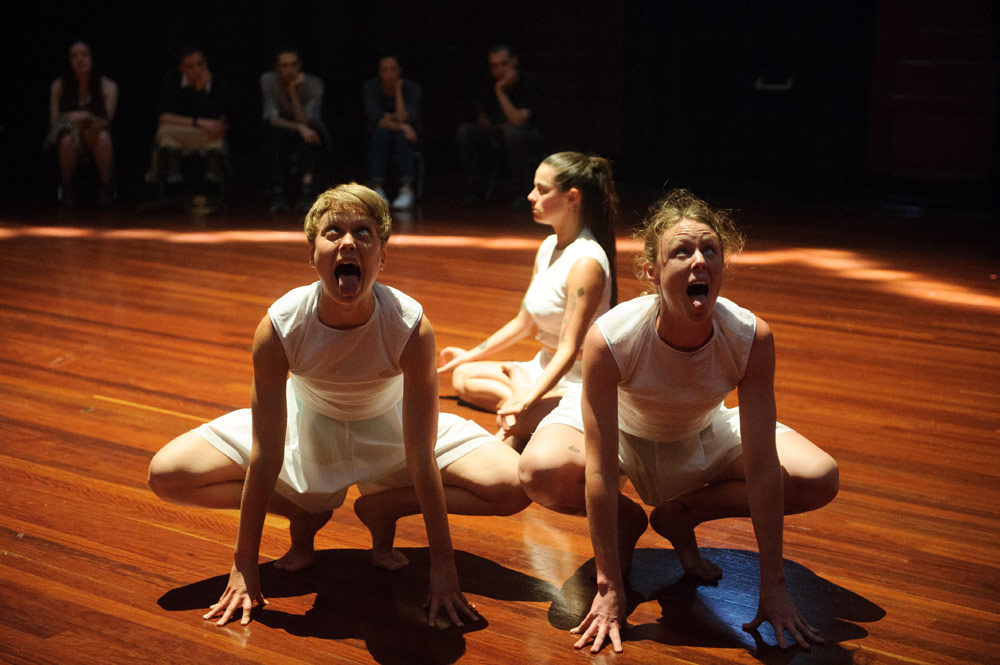
© Sarah Walker. (Click image for larger version)
This is, for lack of a better framing, a cult of performance and a cult in performance.
In its quasi-spiritual themes and framing, Overworld has tapped into an emerging trend in Melbourne contemporary dance, namely the creation of work that uses ritual as a thematic basis, and does so in a way that demonstrates a lack of faith in codified structures, frameworks and hierarchies. From works by Phillip Adams Balletlab (Miracle, Tomorrow, Kingdom), Stephanie Lake (A Small Prometheus), and Gideon Obarzanek (l’Chaim), as well as Rennie McDougall (Yes Dance), Natalie Abbott (Maximum) and Shian Law (Personal Mythologies) – notions of spirituality, ecstasy, self-flagellation, the cult of the body and ritual are becoming a new kind of methodological framework. Underlying all of it, however, seems to be a question about the place in which these contemporary dance choreographers find themselves (or seek to find themselves) in the larger context of the development of a contemporary art form, and also perhaps the extent to which design and visual dramaturgy is speaking to the movement of the physical body.
Shian Law’s Personal Mythologies, for example, draws attention to ritual and spirituality for the purpose of unveiling and exposing its mystery, and fundamentally de-mystifying the ritual of the theatre. As with Overworld, this is a kind of recycling, an investigation and an appropriation of ideas for new purposes. Personal Mythologies premiered in last year’s Next Wave festival, alongside the first iteration of Jensen and Aiken’s Overworld.
Appearing in the foyer in an oversized, yet impressively chic, white shroud, Law invites one audience member at a time through a pair of gilded curtains into a large darkened room. As with Overworld, the entrance to the ‘sacred space’ extends the moment of performance beyond the theatrical environs. Once inside, we are ceremoniously handed off to another similarly dressed ‘guide,’ who carefully places our personal belongings in an enormous net sculpture. Bringing his face very close to mine, my guide, Andrew, instructs me to turn my attention to a black box in a square of light and provides me with a ‘task:’ to ponder how the outer edges of my form relate to the external surfaces of the box. ‘Do you understand?’ he asks before gliding away with an angelic smile.
And so begins Personal Mythologies.

© James Wright. (Click image for larger version)
Across the room, other guides, their expressions sober and hands clasped before their white robes, bequeath tasks or solemnly ferry personal belongings to the net. As the work continues, we see the enormous netted structure, now weighed down with knapsacks and purses and umbrellas and jackets, raised to the ceiling, a forceful symbol that we have checked our identities at the door, and have now entered the pull of Law’s personal mythology. We have been recruited into an unnamed conceptual framework, in which our ‘preconceptions’ about dance (what it is, what it is not) are to be questioned and challenged.
As it turns out, the ‘mythology’ that Shian Law questions in this work is his own dance heritage. He mentions Jo Lloyd and Luke George (two significant Melbourne-based choreographers) as well as American choreographer Deborah Hay as deciding artistic forces in the cult of ‘Shian Law, Artist’. However, the high priestess of Law’s Personal Mythologies is American choreographer Yvonne Rainer. Standing in a narrow corridor of light, arms outstretched as though sacrificing himself to the altar of postmodernism, Law recites parts of Rainer’s No Manifesto with increasing urgency. No to virtuosity! No to Transcendentialism! No to theatre! No…! No…! No.
Law’s invocation of Rainer’s No Manifesto demonstrates the extent to which postmodern dance methodologies have influenced dancers in Australia. As evidenced by this work, American postmodernism remains a factor in the creative processes, frameworks and aesthetic viewpoints of contemporary dancers half a century later- and on the other side of the world. The notion of this anti-establishment text of rebellion, now transformed into a kind of sacred pronouncement to be celebrated as gospel, is incredibly surreal. It is somewhat unsettling to see Rainer’s words invoked in Personal Mythologies in this way as the dancers bark orders at one another- ‘stop dancing!’ ‘Take it down to 80%!’ ‘Make it a duet!’

© James Wright. (Click image for larger version)
Law’s point is nuanced; he has created an environment that is, through its lighting, its ‘guides’, its participation, and through its very chicness – anti-Rainer’s Manifesto. It is the ‘No’ No Manifesto for Melbourne, right now.
Beyond the exploration of postmodern dance in Personal Mythologies is the tipping of contemporary dance towards the realm of pseudo-spirituality and faux-ritual. Law’s process is laid bare, with choreographic scores opened to an interested audience; moreover, the driving forces of the work are rendered mysterious by the semi-sacred way in which they are presented. ‘Guides’ in robes dictating tasks to drive our participation in the work, the ritualistic way in which our belongings are taken from us, performer Jo Lloyd reading aloud from a gold-shrouded pew at one end of the stage, Law appearing on an elevated stage against a white backdrop showing us, in simple movement terms, ‘the essence’ of his work.
There are many parallels here to the pseudo-spirituality in Overworld, and an interesting question about what kinds of structures can be built in the process of deconstructing others. Law himself tells us this is a ‘Mythology;’ this is the creation story of Law’s own artistic development and that mythology is presented as sacrosanct. Overworld offers a different type of mythology altogether. Whether we treat them as sacred or not- well, that perhaps depends on how much we, as spectator/performers, commit to our own place in the pseudo-spiritual world that has been constructed for us.






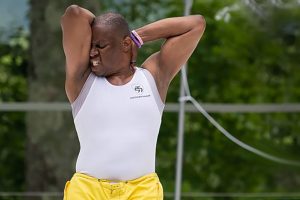

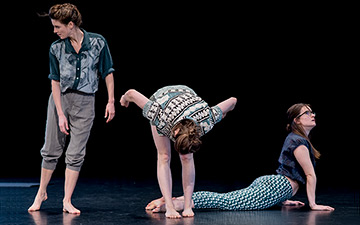
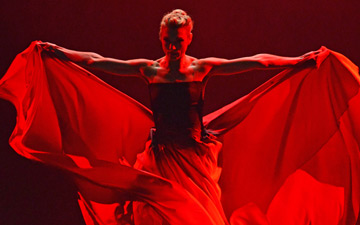
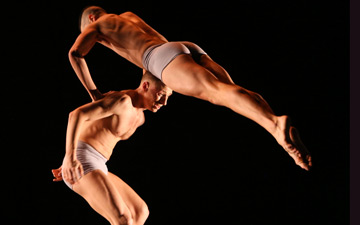
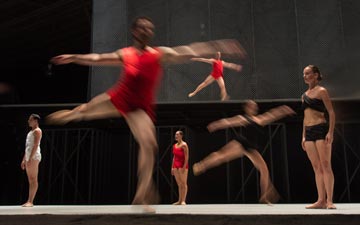


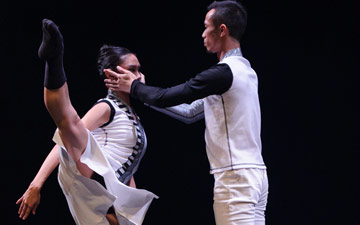
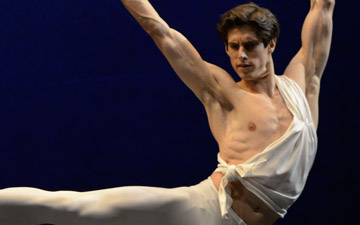

You must be logged in to post a comment.